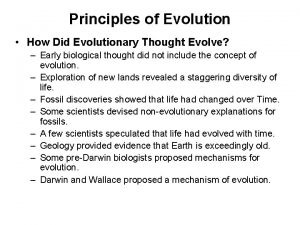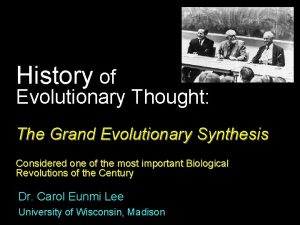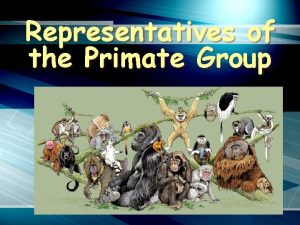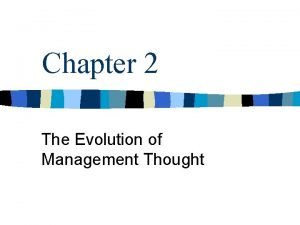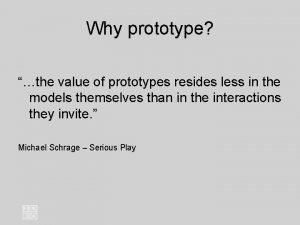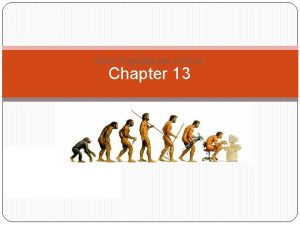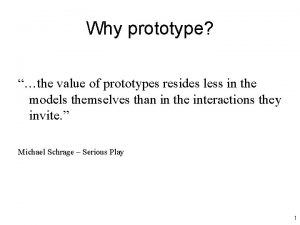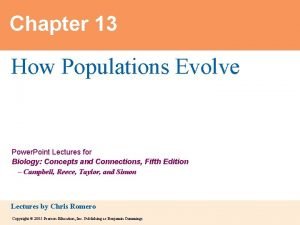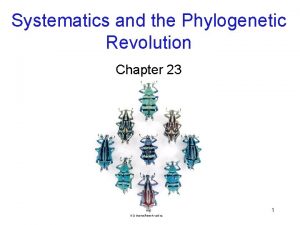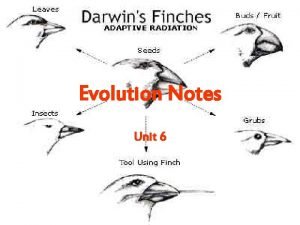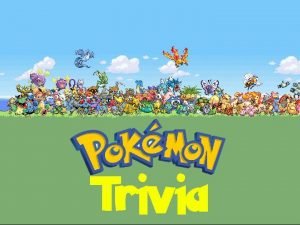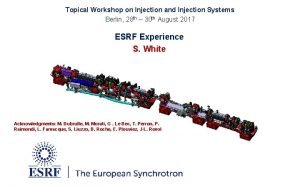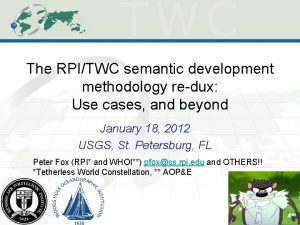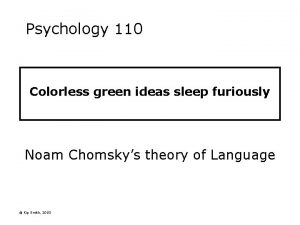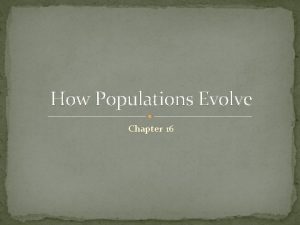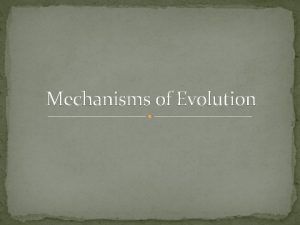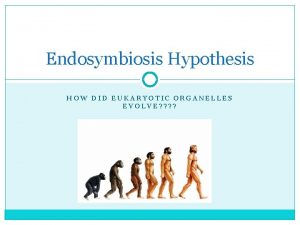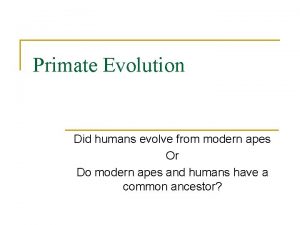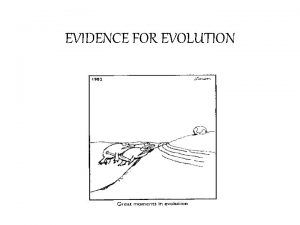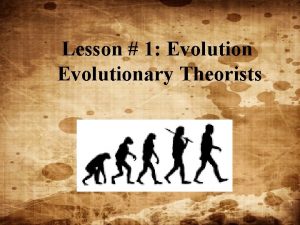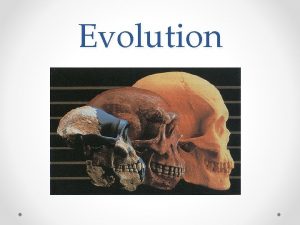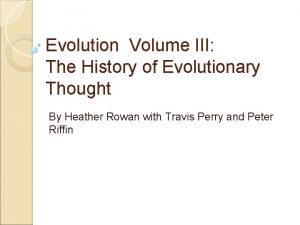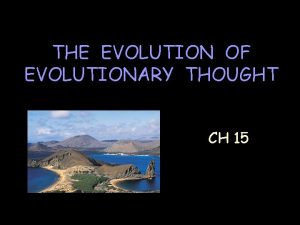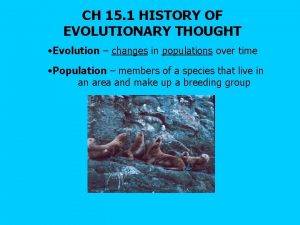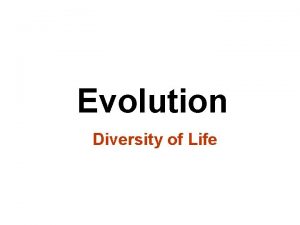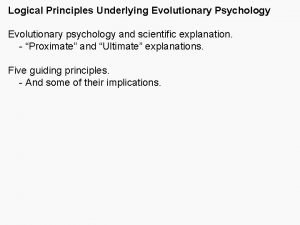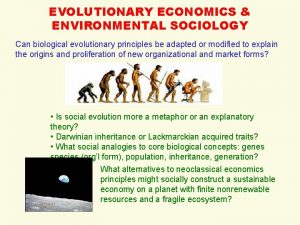Principles of Evolution How Did Evolutionary Thought Evolve




















- Slides: 20

Principles of Evolution • How Did Evolutionary Thought Evolve? – Early biological thought did not include the concept of evolution. – Exploration of new lands revealed a staggering diversity of life. – Fossil discoveries showed that life had changed over Time. – Some scientists devised non-evolutionary explanations for fossils. – A few scientists speculated that life had evolved with time. – Geology provided evidence that Earth is exceedingly old. – Some pre-Darwin biologists proposed mechanisms for evolution. – Darwin and Wallace proposed a mechanism of evolution.

Fossils of extinct organisms • Fossils provide strong support for the idea that today's organisms were not created all at once, but arose over time by the process of evolution. If all species were created simultaneously, we would not expect (a) trilobites to be found in older rock layers than (b) seed ferns, which in turn would not be found deeper than (c) dinosaurs, such as Allosaurus. Trilobites became extinct about 230 million years ago, seed ferns about 150 million years ago, and dinosaurs 65 million years ago.

Principles of Evolution • Darwin studied a group of closely related species of finches on the Galapagos Islands. • Each species specializes in eating a different type of food and has a beak of characteristic size and shape, because natural selection has favored the individuals best suited to exploit each food source efficiently. • Aside from the differences in their beaks, the finches are quite similar.

a. b. c. d. Large ground finch, beak suited to large seeds Small ground finch, beak suited to small seeds Warbler finch, beak suited to insects Vegetarian tree finch, beak suited to leaves

How Does Natural Selection Work? • Modern Genetics confirmed Darwin’s assumption of inheritance. • Natural Selection modifies populations over time. • Fossils provide evidence of evolutionary change over time. • Comparative Anatomy gives evidence of Descent with Modification. • Homologous structures provide evidence of Common Ancestry. • Functionless structures are inherited from ancestors.

• Many organisms have vestigial structures that serve no apparent function. The (a) salamander, (b) whale, and (c) snake all inherited hindlimb bones from a common ancestor; the bones remain functional in the salamander but are vestigial in the whale and snake.

How Do We Know That Evolution Has Occurred? • • • Some anatomical similarities result from evolution in similar environments Embryological similarity suggests common ancestry Modern biochemical and genetic analyses reveal relatedness among diverse organisms.

• Convergent evolution can produce outwardly similar structures that differ anatomically. The wings of (a) insects and (b) birds and the sleek, streamlined shapes of (c) seals and (d) penguins are examples of such analogous structures.

• The early embryonic stages of a (a) lemur, (b) pig, and (c) human show strikingly similar anatomical features.

What Is the Evidence That Populations Evolve by Natural Selection? • Controlled Breeding Modifies Organisms • Evolution by Natural Selection Occurs Today – When fewer predators are present, brighter coloration can evolve. – Natural Selection can lead to pesticide resistance. – Experiments can demonstrate Natural Selection. – Selection acts on random variation to favor the traits that work best in particular environments

Dog diversity illustrates artificial selection • A comparison of (a) the ancestral dog (the gray wolf, Canis lupus) and (b) various breeds of modern dogs. Artificial selection by humans has caused a great divergence in size and shape of dogs in only a few thousand years.

How Are Populations, Genes, and Evolution Related? • Genes and the environment interact to determine traits. • The gene pool is the sum of the genes in a population. • Evolution is the change over time of allele frequencies within a population. • The equilibrium population is a hypothetical population that does not evolve.

What Causes Evolution? • Mutations are the source of Genetic Variability – Mutations are rare, but important – Mutations are not Goal-Directed • Mutations occur spontaneously • Gene flow between populations changes Allele Frequencies. • Allele frequencies may drift in small populations. – Population size matters – A population bottleneck Is an example of Genetic Drift – Population bottlenecks reduce variation

The Effect of Population Size on Genetic Drift • Each colored line represents one computer simulation of the change over time in the frequency of allele A in a (a) large or (b) small population in which two alleles, A and a, were initially present in equal proportions, and in which randomly chosen individuals reproduced.

Population Bottlenecks Reduce Variation • (a) A population bottleneck may drastically reduce genetic and phenotypic variation because the few organisms that survive may carry similar sets of alleles. Both (b) the northern elephant seal and (c) the cheetah passed through population bottlenecks in the recent past, resulting in an almost total loss of genetic diversity.

What Causes Evolution? • Isolated founding populations may produce bottlenecks • Mating within a population Is almost never random • All genotypes are not equally beneficial – Antibiotic resistance evolves by natural selection – Penicillin resistance illustrates key points about evolution

A Human Example of the Founder Effect • An Amish woman with her child, who suffers from a set of genetic defects known as Ellis–van Creveld syndrome (short arms and legs, extra fingers, and, in some cases, heart defects). The founder effect accounts for the prevalence of Ellis–van Creveld syndrome among the Amish residents of Lancaster County, Pennsylvania.

A Compromise Between Opposing Pressures • (a) A male giraffe with a long neck is at a definite advantage in combat to establish dominance. • (b) But a giraffe's long neck forces it to assume an extremely awkward and vulnerable position when drinking. Thus, drinking and male–male contests place opposing evolutionary pressures on neck length.

How Does Natural Selection Work? • Natural selection stems from unequal reproduction • Natural selection acts on phenotypes • Some phenotypes reproduce more successfully than others. – – An environment has non-living and living components Competition acts as an agent of selection Both predator and prey act as agents of selection Sexual selection favors traits that help an organism mate • Selection can influence populations in three ways – Directional selection shifts character traits in a specific direction – Stabilizing selection acts against individuals who deviate too far from the average – Disruptive selection adapts individuals within a population to different habitats.

Three Ways that Selection Affects a Population Over Time • A graphical illustration of three ways natural and/or sexual selection, acting on a normal distribution of phenotypes, can affect a population over time. In all graphs, the beige areas represent individuals that are selected against—that is, do not reproduce as successfully as do the individuals in the purple range.
 History of evolutionary thought
History of evolutionary thought History of evolutionary thought
History of evolutionary thought 5 fingers of evolution
5 fingers of evolution Prosimians
Prosimians Complete vs incomplete thought
Complete vs incomplete thought The evolution of management theory
The evolution of management theory Explore evolve validate prototype
Explore evolve validate prototype Individuals don't evolve populations do
Individuals don't evolve populations do Chapter 13 how populations evolve test
Chapter 13 how populations evolve test Secure assess evolve
Secure assess evolve City and guilds evolve
City and guilds evolve Explore evolve validate prototype
Explore evolve validate prototype Explore engage empower
Explore engage empower Chapter 13 how populations evolve
Chapter 13 how populations evolve Most complex characters evolve
Most complex characters evolve Evolve
Evolve Pokemon dratini
Pokemon dratini Evolve knowledge
Evolve knowledge Evolve berlinist
Evolve berlinist Evolve knowledge
Evolve knowledge Colorless green ideas sleep furiously
Colorless green ideas sleep furiously
